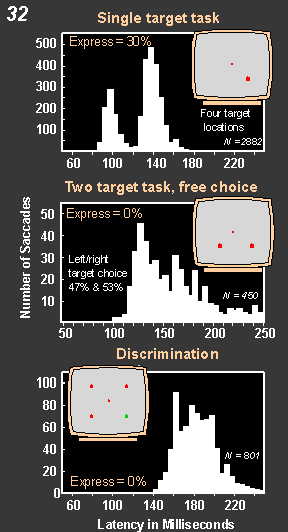The Neural
Control of Visually Guided Eye Movements
D. Temporal Factors in Visually Guided Saccadic Eye Movements
1. The conditions under which express
saccades can and cannot be generated.
c. Can one obtain express saccades when more than
one target appears that requires a decision to be made as to where to
look next?
 Three
conditions were run in randomized sequences to answer this question. The
first is the standard condition already described, in which on each trial
a single target is presented randomly at one of four locations with a
gap of 100ms. This procedure for the monkey shown produced many express
saccades as demonstrated in the top panel of Figure
32. Three
conditions were run in randomized sequences to answer this question. The
first is the standard condition already described, in which on each trial
a single target is presented randomly at one of four locations with a
gap of 100ms. This procedure for the monkey shown produced many express
saccades as demonstrated in the top panel of Figure
32.
The second condition used the simplest multiple
target task we could devise. The monkey was shown two identical targets
after the termination of the fixation spot and was rewarded for making
a saccade to either target. As it turned out, the frequency with which
the left and right targets were chosen with saccadic eye movements was
nearly the same in this situation (47% and 53%). One presumes that on
each trial the monkey had to make a decision as to which target to look
at, simple as that decision may have been. As shown in the middle panel
of Figure 32 the monkey made no
express saccades under these conditions.
For the third procedure monkeys were trained on
an oddity task: four targets appeared one of which was different from
the others. The animal was rewarded only when a saccadic eye movement
was made to the odd stimulus which on each trial appeared randomly at
one of the four locations . The bottom panel in Figure
32 shows the data: the monkey made no express saccades. The
mean latency of the regular saccades for this condition is significantly
longer than that obtained for the other two conditions.
Thus it appears that express saccades arise only
when a single target appears in the visual scene at any given moment in
time.
|